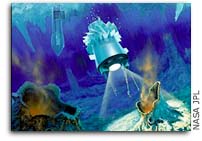From Europa to Sedna: Life Beneath the Ice in the Outer Solar System?

At present, we know of no worlds beyond our Earth where life
exists. However, primitive organisms on our planet have
evolved and adapted over billions of years, colonising the
most inhospitable places.
Since life seems to gain a foothold in the most hostile
environments, it seems distinctly possible that living
organisms could exist in ice-covered oceans on worlds far from
the Sun, according to Dr. David Rothery (Open University), who
will be speaking today at the RAS National Astronomy Meeting
in Milton Keynes.
Europa is the innermost of Jupiter’s large icy satellites. It
is slightly smaller than our own Moon, but its rocky interior
is hidden beneath a 100 km blanket of ice. There has been much
speculation as to whether the ice remains solid right down to
the moon’s rocky interior, or whether it consists of a thinner
ice sheet floating on an ocean of water.
Data from NASA’s Galileo spacecraft, which orbited Jupiter
from 1995 until 2003, provided detailed insights into Europa’s
structure that will not be surpassed until the arrival of
NASA’s Jupiter Icy Moons Orbiter (which may not be until
2023).
The high-resolution Galileo images and other data
revolutionised our knowledge of Europa’s surface and interior
structure, making it seem more likely that the ice is (at
least at some times and in some places) relatively thin (much
less than 10 km) and overlying a liquid water ocean. The
images showed localized areas of ‘melt-through’ demonstrated
by ‘chaos’ regions, where detached rafts of the icy shell can
be seen dispersed in a now-refrozen matrix.
The cause of melt-through is likely to be tidal heating, which
is especially strong within Europa because it orbits within
the immense gravity of Jupiter and experiences competing tidal
pulls from the large, neighbouring moons, Io and Ganymede.
This process also powers the widespread volcanic eruptions on
Io.
There may be occasional volcanic eruptions onto Europa’s ocean
floor – rather like a less active, ice-covered version of Io –
or, more likely, hot springs where chemically-enriched water
heated by passage through the rock re-emerges on the ocean
floor.
This sort of environment is currently regarded as the most
likely place for life on Earth to have begun, and life on
Europa could have arisen in just the same way. If so, life
could survive there today, supported by chemical energy in the
same way that the ‘hydrothermal vents’ on Earth’s ocean floors
support ecosystems that do not depend on sunlight.
"Episodes of tidal heating in some of the Solar System’s other
icy bodies could equally well have given rise to life, even in
such remote bodies as the newly discovered, remote planetoid
Sedna if, as has been suggested, it has a satellite with which
to interact tidally," said Dr. Rothery. "However, only in the
case of Europa, and perhaps a few other satellites of the
giant planets, does it seem plausible that life could flourish
in the long term."
NOTES FOR EDITORS
The 2004 RAS National Astronomy Meeting is hosted by the Open
University, and sponsored by the UK Particle Physics and
Astronomy Research Council (PPARC).
CONTACT:
From 30 March to 2 April, Dr. Rothery can be contacted via the
NAM press office (see above).
Normal contact details:
Dr. David A. Rothery Dept of Earth Sciences The Open
University Milton Keynes MK7 6AA Tel: +44 (0)1908 652124 Fax:
+44 (0)1908 655151 Mobile: +44 (0)7986-260258 E-mail:
d.a.rothery@open.ac.uk
FURTHER INFORMATION AND IMAGES CAN BE FOUND ON THE WEB AT:
NASA Galileo Web site:
http://galileo.jpl.nasa.gov/
http://galileo.jpl.nasa.gov/images/europa/eurimages.html
http://galileo.jpl.nasa.gov/images/europa/eurchaotic.html









